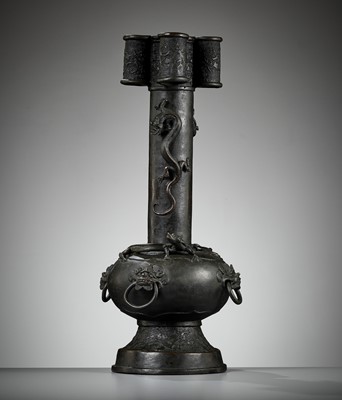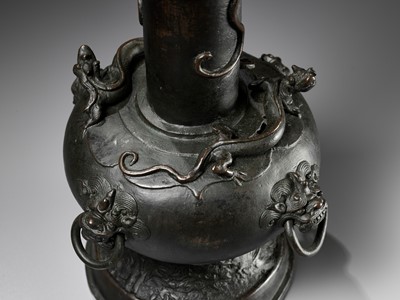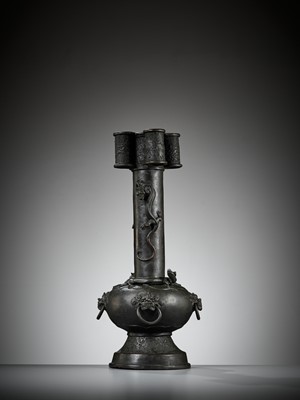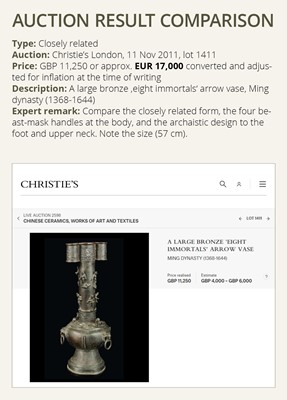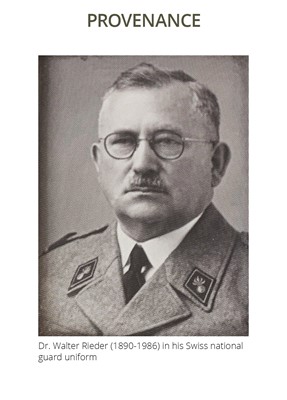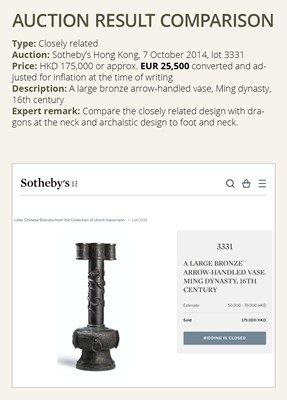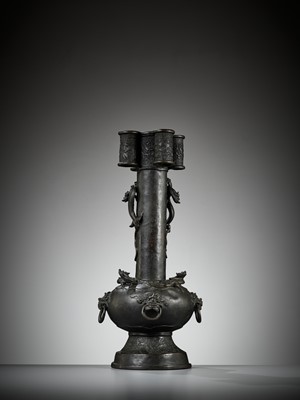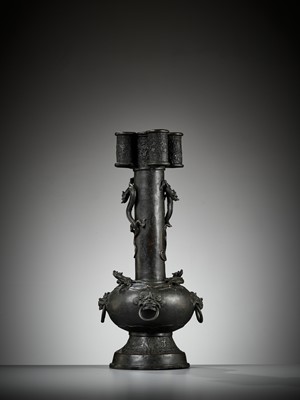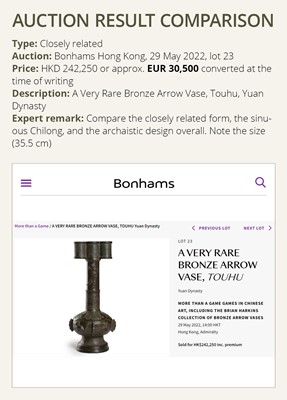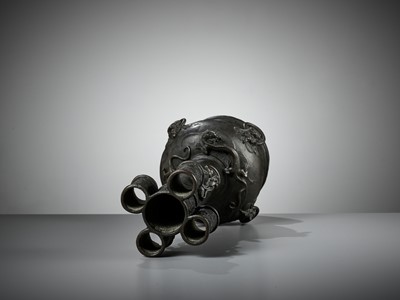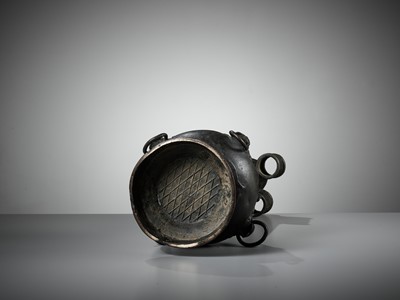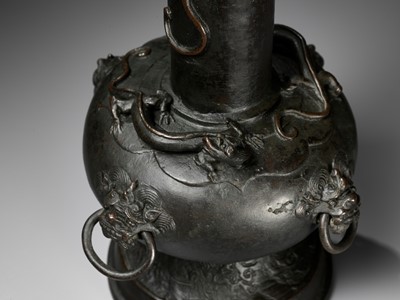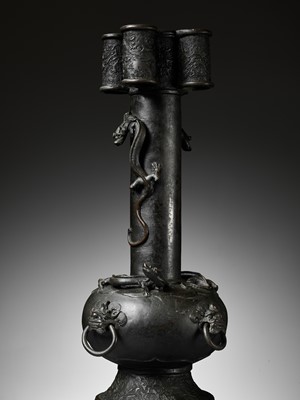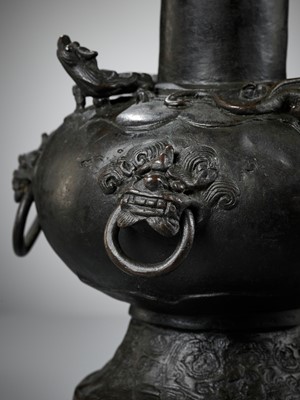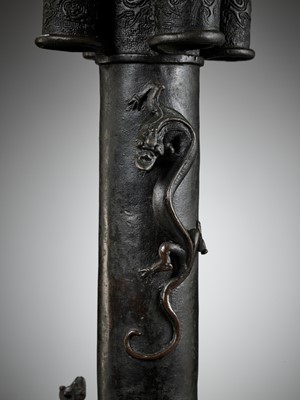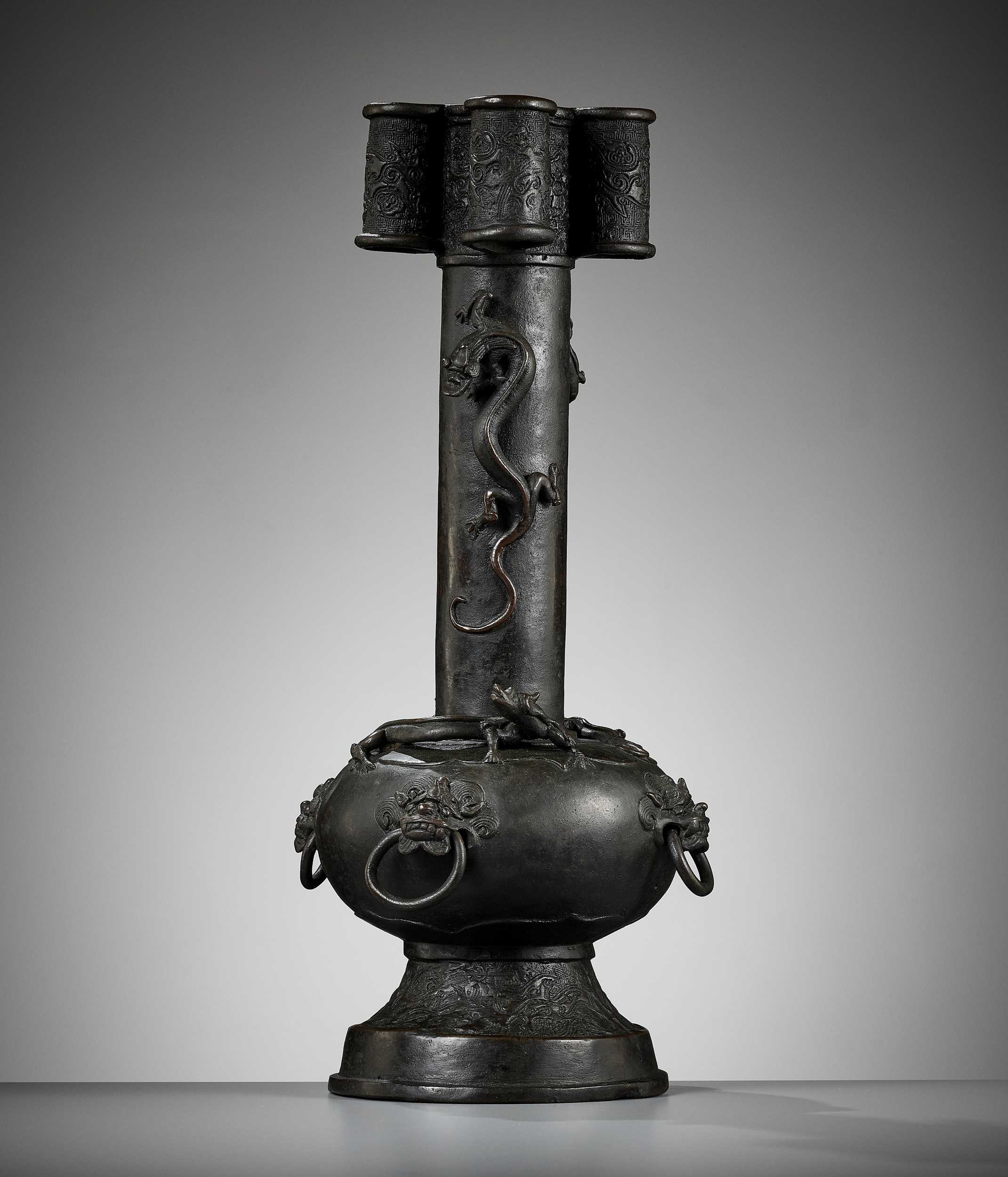29th Sep, 2022 13:00
DAY 1 - TWO-DAY AUCTION - Fine Chinese Art / 中國藝術集珍 / Buddhism & Hinduism
143
A LARGE AND MASSIVE BRONZE ‘CHILONG’ ARROW VASE, TOUHU, YUAN TO EARLY MING DYNASTY
元至明初大型螭龍紋輔首啣環投壺
Sold for €10,400
including Buyer's Premium
China, 13th-15th century. Heavily cast, the compressed globular body rising from a splayed foot and surmounted by a tall cylindrical neck. The body decorated in relief with archaistic motifs on a key-fret diapered ground at the foot and the four tubular ‘target’ lugs, further molded with four beast-mask handles suspending loose rings, and four chilong sinuously wrapping around the shoulder and elongated neck.
Provenance: From the collection of Dr. Walter Rieder (1890-1986), and thence by descent in the same family. Dr. Walter Rieder served in the Swiss East Asia Mission (SOAM) in Qingdao, Shandong Province, between October 1930 and December 1951. The mission specialized in educational, literary, and philanthropic work and Dr. Rieder was in fact, not a theologian or missionary, but a teacher of mathematics, physics, and science to high school students attached to the SOAM. His guiding principles were 'Creating understanding between different cultures' and 'Building bridges between East and West'. While in Qingdao, Dr. Rieder collected a wide variety of Chinese art. The objects in the collection thus offer a unique window into the type of antiques that were on the market in Qingdao in the second quarter of the 20th century. As well as demonstrating his passion for Chinese art, his collection also reveals the personal friendships Dr. Rieder forged with local artists, some of whom he knew from his teaching activities. Dr. Rieder had a scholarly approach to studying his collection. Alongside many of his objects, meticulous notes can sometimes be found detailing his art historical commentaries. The collection was hence Dr. Rieder's gateway to the history and culture of China. Objects from the collection were exhibited at the Kunsthaus in Interlaken, Switzerland in 2006 and 2018.
Condition: Very good condition with extensive old wear, few casting irregularities, small losses, nicks and dents, a small hole to the shoulder, possibly inherent to the manufacture. The base plate shows some soldering, but is original to the vase. Dark, naturally grown patina, exactly as expected from this type of bronze.
Weight: 6,448 g
Dimensions: Height 47.8 cm
The form of this vase is inspired by archaic bronze vessels used for touhu (lit. ‘pitch-pot’), a traditional East Asian game that requires players to throw arrows or sticks from a set distance into a large, sometimes ornate, vessel. The game had originated by the Warring States period, probably invented by archers or soldiers as a pastime during idle periods. It began as a game of skill or a drinking game at parties, but by the time it was described in a chapter of the Chinese Classic Book of Rites, it had acquired Confucian moral overtones. Initially popular among elites, it spread to other classes and remained popular in China until the end of the Qing Dynasty. Touhu was usually a contest between players, who had to throw arrows into the mouth or tubular lugs located at the top of the vase, which was placed at an equal distance between two mats on which the players knelt. Touhu vases continued to be produced in the Song dynasty and later, made in various materials including bronze, cloisonné, and ceramic.
Literature comparison:
See a related bronze arrow vase, dated as first half 17th century, illustrated in The Chinese Scholar's Studio: Artistic Life in the Late Ming Period, New York, 1987, no. 63.
Auction result comparison:
Type: Closely related
Auction: Christie’s London, 11 Nov 2011, lot 1411
Price: GBP 11,250 or approx. EUR 17,000 converted and adjusted for inflation at the time of writing
Description: A large bronze 'eight immortals' arrow vase, Ming dynasty (1368-1644)
Expert remark: Compare the closely related form, the four beast-mask handles at the body, and the archaistic design to the foot and upper neck. Note the size (57 cm).
Auction result comparison:
Type: Closely related
Auction: Sotheby’s Hong Kong, 7 October 2014, lot 3331
Price: HKD 175,000 or approx. EUR 25,500 converted and adjusted for inflation at the time of writing
Description: A large bronze arrow-handled vase, Ming dynasty, 16th century
Expert remark: Compare the closely related design with dragons at the neck and archaistic design to foot and neck.
Auction result comparison:
Type: Closely related
Auction: Bonhams Hong Kong, 29 May 2022, lot 23
Price: HKD 242,250 or approx. EUR 30,500 converted at the time of writing
Description: A Very Rare Bronze Arrow Vase, Touhu, Yuan Dynasty
Expert remark: Compare the closely related form, the sinuous chilong, and the archaistic design overall. Note the size (35.5 cm).
元至明初大型螭龍紋輔首啣環投壺
中國,十三至十五世紀。該件瓶為銅質。唇口,口沿兩側附雙貫耳,形成三個並列的口部,貫耳下端亦為唇口,雷紋地龍紋。細長頸,圓雕兩螭龍攀附。平肩,肩部攀附一對螭龍。鼓腹,四輔首啣環。高圈足。壺整器規矩,錯落有致。
來源:Dr. Walter Rieder (1890-1986)舊藏,在同一家族保存至今。Dr. Walter Rieder 1930 年 10 月至 1951 年 12 月間在山東青島的瑞士東亞傳道部 (SOAM) 任職。該傳道部專門從事教育、文學和慈善工作,而Rieder博士實際上不是神學家或傳教士,而是一位SOAM 附屬高中的數學、物理和科學教師。他的教育原則是“在不同文化之間建立理解”和“在東西方之間架起橋樑”。在青島期間,Rieder博士收藏了種類繁多的中國藝術品。收藏中的物品為了解二十世紀下半葉青島的古玩類型提供了一個獨特的窗口。他的收藏除了展現他對中國藝術的熱情外,還可從中看出Rieder博士與當地藝術家建立的個人友誼,其中一些藝術家是他從教學活動中認識的。Rieder 博士採用學術方法研究他的收藏。除了他的許多藏品外,有時還可以找到細緻的筆記,詳細介紹其藝術發展史。因此,其收藏成為 Rieder 博士了解中國歷史和文化的窗口。他的收藏曾於 2006 年和 2018年 年在瑞士因特拉肯美術館館展出。
品相:品相極好,大面積磨損,輕微鑄造瑕疵,小缺損、小刻痕和凹痕,肩部有一個小孔,可能是製造時出現的。底板看上去有過焊接。深色的包漿,與這種青銅器皿的預期完全一樣。
重量:6,448 克
尺寸:高47.8 厘米
投壺由青銅器型演變而來,是東亞傳統遊戲用具。投壺最早應是東周與春秋左近出現,源流本為“射禮”。最早投壺不是遊戲,而是諸侯國間的國家禮儀。投壺成為遊戲,是戰國後期才開始的。此等遊戲,在皇家燕宴,士大夫、文人們宴飲或雅集之際,必得以“雅歌”伴“投壺”助興。其投壺技巧百出,有背向反投者,遮目盲投者,隔了屏風越投者,或各種舞蹈技藝投壺者等等。投壺通常是玩家之間的競賽,投壺放置在兩張墊子之間,玩家跪在上面,距離相等,他們必須將箭射入位於花瓶頂部的口或兩側的貫耳。投壺在宋代及以後使用各種材料製作,包括青銅、景泰藍和陶瓷。
文獻比較:
見一件相近的十七世紀上半葉青銅投壺,見《The Chinese Scholar's Studio: Artistic Life in the Late Ming Period》,紐約,1987年,編號63。
拍賣結果比較:
形制:非常相近
拍賣:倫敦佳士得,2011年11月11日,lot 1411
價格:GBP 11,250(相當於今日EUR 17,000)
描述:明代大型八仙青銅投壺
專家評論:比較非常相近的外型、腹部四面輔首啣環、仿古設計。請注意尺寸 (57 厘米)。
拍賣結果比較:
形制:非常相近
拍賣:香港蘇富比,2014年10月7日,lot 3331
價格:HKD 175,000(相當於今日EUR 25,500)
描述:十六世紀明代大型青銅投壺
專家評論:比較非常相近的頸部龍紋、仿古設計。
拍賣結果比較:
形制:非常相近
拍賣:香港邦瀚斯,2022年5月29日,lot 23
價格:HKD 242,250(相當於今日EUR 30,500)
描述:元代銅螭龍紋雙貫耳投壺
專家評論:比較非常相近的外型、頸部盤旋的螭龍,以及仿古設計。請注意尺寸(35.5 厘米)。
China, 13th-15th century. Heavily cast, the compressed globular body rising from a splayed foot and surmounted by a tall cylindrical neck. The body decorated in relief with archaistic motifs on a key-fret diapered ground at the foot and the four tubular ‘target’ lugs, further molded with four beast-mask handles suspending loose rings, and four chilong sinuously wrapping around the shoulder and elongated neck.
Provenance: From the collection of Dr. Walter Rieder (1890-1986), and thence by descent in the same family. Dr. Walter Rieder served in the Swiss East Asia Mission (SOAM) in Qingdao, Shandong Province, between October 1930 and December 1951. The mission specialized in educational, literary, and philanthropic work and Dr. Rieder was in fact, not a theologian or missionary, but a teacher of mathematics, physics, and science to high school students attached to the SOAM. His guiding principles were 'Creating understanding between different cultures' and 'Building bridges between East and West'. While in Qingdao, Dr. Rieder collected a wide variety of Chinese art. The objects in the collection thus offer a unique window into the type of antiques that were on the market in Qingdao in the second quarter of the 20th century. As well as demonstrating his passion for Chinese art, his collection also reveals the personal friendships Dr. Rieder forged with local artists, some of whom he knew from his teaching activities. Dr. Rieder had a scholarly approach to studying his collection. Alongside many of his objects, meticulous notes can sometimes be found detailing his art historical commentaries. The collection was hence Dr. Rieder's gateway to the history and culture of China. Objects from the collection were exhibited at the Kunsthaus in Interlaken, Switzerland in 2006 and 2018.
Condition: Very good condition with extensive old wear, few casting irregularities, small losses, nicks and dents, a small hole to the shoulder, possibly inherent to the manufacture. The base plate shows some soldering, but is original to the vase. Dark, naturally grown patina, exactly as expected from this type of bronze.
Weight: 6,448 g
Dimensions: Height 47.8 cm
The form of this vase is inspired by archaic bronze vessels used for touhu (lit. ‘pitch-pot’), a traditional East Asian game that requires players to throw arrows or sticks from a set distance into a large, sometimes ornate, vessel. The game had originated by the Warring States period, probably invented by archers or soldiers as a pastime during idle periods. It began as a game of skill or a drinking game at parties, but by the time it was described in a chapter of the Chinese Classic Book of Rites, it had acquired Confucian moral overtones. Initially popular among elites, it spread to other classes and remained popular in China until the end of the Qing Dynasty. Touhu was usually a contest between players, who had to throw arrows into the mouth or tubular lugs located at the top of the vase, which was placed at an equal distance between two mats on which the players knelt. Touhu vases continued to be produced in the Song dynasty and later, made in various materials including bronze, cloisonné, and ceramic.
Literature comparison:
See a related bronze arrow vase, dated as first half 17th century, illustrated in The Chinese Scholar's Studio: Artistic Life in the Late Ming Period, New York, 1987, no. 63.
Auction result comparison:
Type: Closely related
Auction: Christie’s London, 11 Nov 2011, lot 1411
Price: GBP 11,250 or approx. EUR 17,000 converted and adjusted for inflation at the time of writing
Description: A large bronze 'eight immortals' arrow vase, Ming dynasty (1368-1644)
Expert remark: Compare the closely related form, the four beast-mask handles at the body, and the archaistic design to the foot and upper neck. Note the size (57 cm).
Auction result comparison:
Type: Closely related
Auction: Sotheby’s Hong Kong, 7 October 2014, lot 3331
Price: HKD 175,000 or approx. EUR 25,500 converted and adjusted for inflation at the time of writing
Description: A large bronze arrow-handled vase, Ming dynasty, 16th century
Expert remark: Compare the closely related design with dragons at the neck and archaistic design to foot and neck.
Auction result comparison:
Type: Closely related
Auction: Bonhams Hong Kong, 29 May 2022, lot 23
Price: HKD 242,250 or approx. EUR 30,500 converted at the time of writing
Description: A Very Rare Bronze Arrow Vase, Touhu, Yuan Dynasty
Expert remark: Compare the closely related form, the sinuous chilong, and the archaistic design overall. Note the size (35.5 cm).
元至明初大型螭龍紋輔首啣環投壺
中國,十三至十五世紀。該件瓶為銅質。唇口,口沿兩側附雙貫耳,形成三個並列的口部,貫耳下端亦為唇口,雷紋地龍紋。細長頸,圓雕兩螭龍攀附。平肩,肩部攀附一對螭龍。鼓腹,四輔首啣環。高圈足。壺整器規矩,錯落有致。
來源:Dr. Walter Rieder (1890-1986)舊藏,在同一家族保存至今。Dr. Walter Rieder 1930 年 10 月至 1951 年 12 月間在山東青島的瑞士東亞傳道部 (SOAM) 任職。該傳道部專門從事教育、文學和慈善工作,而Rieder博士實際上不是神學家或傳教士,而是一位SOAM 附屬高中的數學、物理和科學教師。他的教育原則是“在不同文化之間建立理解”和“在東西方之間架起橋樑”。在青島期間,Rieder博士收藏了種類繁多的中國藝術品。收藏中的物品為了解二十世紀下半葉青島的古玩類型提供了一個獨特的窗口。他的收藏除了展現他對中國藝術的熱情外,還可從中看出Rieder博士與當地藝術家建立的個人友誼,其中一些藝術家是他從教學活動中認識的。Rieder 博士採用學術方法研究他的收藏。除了他的許多藏品外,有時還可以找到細緻的筆記,詳細介紹其藝術發展史。因此,其收藏成為 Rieder 博士了解中國歷史和文化的窗口。他的收藏曾於 2006 年和 2018年 年在瑞士因特拉肯美術館館展出。
品相:品相極好,大面積磨損,輕微鑄造瑕疵,小缺損、小刻痕和凹痕,肩部有一個小孔,可能是製造時出現的。底板看上去有過焊接。深色的包漿,與這種青銅器皿的預期完全一樣。
重量:6,448 克
尺寸:高47.8 厘米
投壺由青銅器型演變而來,是東亞傳統遊戲用具。投壺最早應是東周與春秋左近出現,源流本為“射禮”。最早投壺不是遊戲,而是諸侯國間的國家禮儀。投壺成為遊戲,是戰國後期才開始的。此等遊戲,在皇家燕宴,士大夫、文人們宴飲或雅集之際,必得以“雅歌”伴“投壺”助興。其投壺技巧百出,有背向反投者,遮目盲投者,隔了屏風越投者,或各種舞蹈技藝投壺者等等。投壺通常是玩家之間的競賽,投壺放置在兩張墊子之間,玩家跪在上面,距離相等,他們必須將箭射入位於花瓶頂部的口或兩側的貫耳。投壺在宋代及以後使用各種材料製作,包括青銅、景泰藍和陶瓷。
文獻比較:
見一件相近的十七世紀上半葉青銅投壺,見《The Chinese Scholar's Studio: Artistic Life in the Late Ming Period》,紐約,1987年,編號63。
拍賣結果比較:
形制:非常相近
拍賣:倫敦佳士得,2011年11月11日,lot 1411
價格:GBP 11,250(相當於今日EUR 17,000)
描述:明代大型八仙青銅投壺
專家評論:比較非常相近的外型、腹部四面輔首啣環、仿古設計。請注意尺寸 (57 厘米)。
拍賣結果比較:
形制:非常相近
拍賣:香港蘇富比,2014年10月7日,lot 3331
價格:HKD 175,000(相當於今日EUR 25,500)
描述:十六世紀明代大型青銅投壺
專家評論:比較非常相近的頸部龍紋、仿古設計。
拍賣結果比較:
形制:非常相近
拍賣:香港邦瀚斯,2022年5月29日,lot 23
價格:HKD 242,250(相當於今日EUR 30,500)
描述:元代銅螭龍紋雙貫耳投壺
專家評論:比較非常相近的外型、頸部盤旋的螭龍,以及仿古設計。請注意尺寸(35.5 厘米)。
Zacke Live Online Bidding
Our online bidding platform makes it easier than ever to bid in our auctions! When you bid through our website, you can take advantage of our premium buyer's terms without incurring any additional online bidding surcharges.
To bid live online, you'll need to create an online account. Once your account is created and your identity is verified, you can register to bid in an auction up to 12 hours before the auction begins.
Intended Spend and Bid Limits
When you register to bid in an online auction, you will need to share your intended maximum spending budget for the auction. We will then review your intended spend and set a bid limit for you. Once you have pre-registered for a live online auction, you can see your intended spend and bid limit by going to 'Account Settings' and clicking on 'Live Bidding Registrations'.
Your bid limit will be the maximum amount you can bid during the auction. Your bid limit is for the hammer price and is not affected by the buyer’s premium and VAT. For example, if you have a bid limit of €1,000 and place two winning bids for €300 and €200, then you will only be able to bid €500 for the rest of the auction. If you try to place a bid that is higher than €500, you will not be able to do so.
Online Absentee and Telephone Bids
You can now leave absentee and telephone bids on our website!
Absentee Bidding
Once you've created an account and your identity is verified, you can leave your absentee bid directly on the lot page. We will contact you when your bids have been confirmed.
Telephone Bidding
Once you've created an account and your identity is verified, you can leave telephone bids online. We will contact you when your bids have been confirmed.
Classic Absentee and Telephone Bidding Form
You can still submit absentee and telephone bids by email or fax if you prefer. Simply fill out the Absentee Bidding/Telephone bidding form and return it to us by email at office@zacke.at or by fax at +43 (1) 532 04 52 20. You can download the PDF from our Upcoming Auctions page.
How-To Guides
How to Create Your Personal Zacke Account
How to Register to Bid on Zacke Live
How to Leave Absentee Bids Online
How to Leave Telephone Bids Online
中文版本的操作指南
创建新账号
注册Zacke Live在线直播竞拍(免平台费)
缺席投标和电话投标
Third-Party Bidding
We partner with best-in-class third-party partners to make it easy for you to bid online in the channel of your choice. Please note that if you bid with one of our third-party online partners, then there will be a live bidding surcharge on top of your final purchase price. You can find all of our fees here. Here's a full list of our third-party partners:
- 51 Bid Live
- EpaiLive
- ArtFoxLive
- Invaluable
- LiveAuctioneers
- the-saleroom
- lot-tissimo
- Drouot
Please note that we place different auctions on different platforms. For example, in general, we only place Chinese art auctions on 51 Bid Live.
Bidding in Person
You must register to bid in person and will be assigned a paddle at the auction. Please contact us at office@zacke.at or +43 (1) 532 04 52 for the latest local health and safety guidelines.
